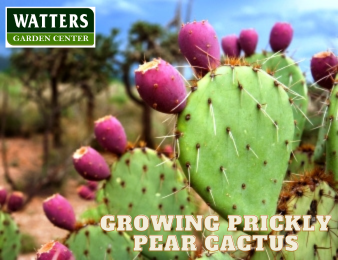By Ken Lain, the mountain gardner


Large, beautiful yellow flowers rest on the outer edges of spine-covered pads. The pads often turn a rich purple color in winter and return to a soft blue-gray through the growing season. An excellent choice for year-round beauty in arid xeric landscapes or containers. Perennial evergreen at all elevations.
The stems are flat paddle-like segments approximately 2-7″ inches long with a blue tint. A staple of the Mexican and Central American diet, and gaining popularity as an exotic, healthy addition to diets. Prickly Pear Cactus has three edible sections: the cactus (nopal) pad treated like a vegetable. Flowers petals are added to salads, and the pear (tuna) is treated like a fruit.
Prickly pears are cacti and need well-draining soil first and foremost. Plant in 6+ hours of sun with sandy to gravely garden soil, and go easy on the water. Also, don’t be alarmed if your plants appear to deflate through winter; this is a dormancy response and will plump back up in spring.
Light
Prickly Pear thrives with 6+ hours of sun. The more, the better. More light grows a larger plant and more blooms through spring and Summer.
Soil
Requires well-drained soil to thrive and grows exceptionally well in containers. Best planted in Cactus Potting Soil for easy garden care.
Water
Prickly pear cactus is highly drought tolerant. When it comes to water, if in doubt, leave it out. The rainfall will likely be enough for the cactus to thrive. Plan to water your plants by hand every two to four weeks, even in the hottest summer seasons.
Temperature and Humidity
Like any cactus, the prickly pear likes warm, dry weather. Though it’s more cold-hearty than other cacti and survives down to 14 degrees. They want to be dry, so additional humidity (like misting the plant) is unnecessary.
Fertilizer
Cactus prefer a lighter fertilizer. Use Watters Flower Power monthly from April through October for spectacular blooms and better fruits.
Types of Prickly Pear Cactus
- Beavertail, Opuntia basilaris, This pink-flowered variety blooms in the spring and is found natively up to 8,000 feet.
- Englemann, Opuntia engelmannii, Known for deep red or purple fruits, this variety has wide-spaced spines.
- Mojave, Opuntia erinacea, The mature plant doesn’t offer much fruit and grows best at over 3,500+ feet of elevation.
- Santa Rita, Opuntia santa-rita, This striking variety offers vibrant blue-gray to purple pads.
Pruning
Remove pads from the plant to maintain proper shape. Hold the pad with tongs or a hand covered in a thick glove and cut the pad at the base.
Potting and Repotting Prickly Pear Cactus
Choose a container with numerous drainage holes and a Cactus potting soil designed for cacti. Grow in a container a few inches broader than the most oversized pad. The cactus can grow in this container for seasons to come.
Common Pests and Plant Diseases
The most common problem when growing cactus is giving it too much water, which can cause its shallow, fibrous roots to rot and the cactus to collapse. Scale and Mealybug are possible pests on cactus. Both are easily treated with Triple Action Neem Oil.
How to Get Prickly Pear Cactus to Bloom
Prickly pear cactus might not bloom for the first few years. Cactus prefer a lighter fertilizer. Use Watters Flower Power monthly from April through October for spectacular blooms and better fruits. When reaching maturity and setting fruit, cut the flowers back to about 10 per pad to encourage plenty of room for fruit growth.

Free Garden Classes are offered @ Watters Garden Center
We go deep into growing better. Check out this Summer’s class selection offered every Saturday @ 9:30 am.
August 19 – Top 10 Evergreens for Mountain Landscapes
August 26 – Gardening for Newcomers
September 2 – Top 10 Trees and How to Plant Them
Until next week, I’ll be helping gardeners with cute houseplants here at Watters Garden Center.
Ken Lain can be found throughout the week at Watters Garden Center, 1815 Iron Springs Rd in Prescott, or contacted through his website at WattersGardenCenter.com or Top10Plants.com.

